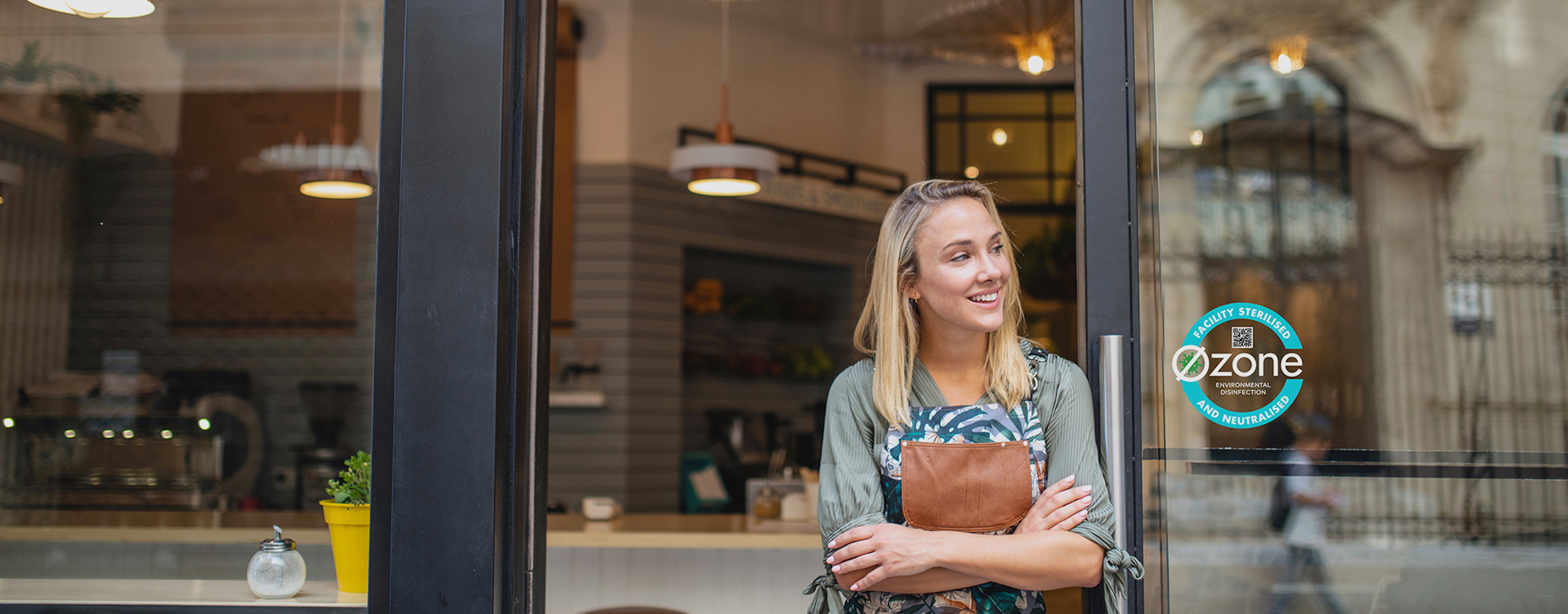
16 Jun 10 Essential Facts You Need to Know about Ozone Disinfection
Ozone Disinfection is a gas. A non-toxic, chemical free disinfectant!
Are you wanting to find a quick and safe method of keeping your interior disinfected
and the air you breathe bacteria-free?Are you looking at keeping your family, customers and employees germ-free?
Ozone disinfection is a quick method to kill bacteria, neutralise viruses, stop mould and eliminate odours, leaving your indoor space smelling as fresh as a daisy.
Need to know more? Here are 10 essential facts about ozone disinfection:
1. How does ozone gas disinfect?
Ozone is a naturally occurring gas created from oxygen atoms. Ozone generators produce ozone by using a high voltage current to break apart oxygen (O²) molecules into single atoms, which then attach to other oxygen molecules in the air to form Ozone (O³).
The Ozone generator rapidly fills the treatment area with this gas to achieve a high concentration where the process of oxidisation quickly and efficiently occurs, killing bacteria and neutralising viruses on any hard or soft surfaces including carpets, curtains, fabrics, keyboards, pens and any other object within the treatment area. At the end of the treatment cycle the Ozone gas (O³) simply reverts back to Oxygen (O²) without toxic residue.
2. Why is ozone used as a disinfectant?
Ozone easily attaches to pollution, especially odorous compounds like smoke and organic matter such as viruses, bacteria and mould spores. Most infections occur because of the invasion of anaerobes that do not thrive in an oxygen-rich environment. Ozone disinfection deprives the cells of oxygen, encouraging anaerobic microbes to flourish. An abundance of harmful bacteria will cause a breakdown of enzymatic reactions, an overload of metabolic wastes and eventually, the cells die. The World Health Organisation states that Ozone is the most efficient disinfectant for all types of microorganisms.
Ozone sterilisation works great for areas with lots of high-touch surfaces that are impossible to get to with traditional bleach or chlorine. Ozone will kill pathogens on every surface the gas touches, including the air itself. Ozone more significantly disinfects hard to reach spots including inside air conditioning ducts, filing cabinets, carpets and floor coverings, upholstery fabrics, bedding and pillows, clothing left hanging in the treatment area, pens, keyboards and behind furniture. Any surface or object that is exposed to the Ozone gas.
3. What is the history of ozone disinfection?
Ozone disinfection is not a new concept. It was discovered in the 1840s by the German chemist Schönbein and used in a water purification process. The first big-scale application of ozone took place in Oudshoorn, Netherlands, in 1893. This ozone installation was studied by French scientists, and a unit was installed in Nice in the 1900s for water mains disinfection. Nice would go on to become the ‘place of birth of ozone for drinking water treatment’, while the rest of the world went on to discover the harmfulness of chlorine.
4. How is ozone disinfection used?
Ozone is used to limit the spread of airborne microorganisms in indoor spaces, including ventilation ducts.
As an example in the dairy industry, equipment is sanitised using ozone, eliminating the use of harmful chemical disinfectants. In hospitals that have high cleanliness requirements and already employ frequent cleaning to reduce the spread of pathogens, this is commonly done by frequent wiping of surfaces with chemical disinfectants.
5. Where is ozone disinfection used?
|
|
6. Does ozone kill bacteria in the air?
Yes it does.
Ozone is a gas and it disinfects anything in the treatment area where a specific concentration of Ozone gas is achieved and maintained for a period of time. This includes the air in the space and any other surface or object in that treatment area.
The kill rate of bacteria and neutralisation of viruses and mould is 97%.
Unlike laboratory experiments conducted by Kowalski et al (1) that could remove 99.99% airborne bacteria after ozonation, the best reduction percentage in most tests conducted around the world was 97%.
The higher elimination percentage cannot always be achieved because rooms are not 100% air tight.
7. What is the difference between cleaning and disinfecting?
Cleaning refers to the removal of germs and dirt from surfaces. Cleaning will not kill germs; it simply removes them or reduces the number of germs on a surface in order to lower the risk of infection.
Disinfecting is a process that typically uses chemicals to kill germs. Disinfecting makes bacteria and viruses incapable of reproducing in the host.
We recommend that cleaning the area and removing any sources of dust, dirt and odour be done first. Ozone generators do not remove particulate matter like dust or pollen (which are often allergens) from the air.
8. Why is ozone better than chlorine as a disinfectant?
Ozone is over 3000 times faster when purifying water. Ozone is more potent, faster at disinfecting and is chemical-free. In the long run, using the ozone generating machine is cheaper than buying chemicals.
9. Is ozone disinfection dangerous?
An ozone generator should only be used by trained personnel as high concentrations of Ozone are dangerous to humans and pets. Ozone is a lung irritant that can cause adverse health effects. For those with underlying disease, asthma and lung conditions, exposure to ozone is hazardous.
When an ozone generator is used in a room, no humans or pets must be in that space for the whole time the machine is in use.
An untrained individual managing a generic ozone generator can not only be dangerous but also ineffective. A low dose of Ozone will not effectively kill bacteria or inactivate some viruses, spores, and cysts. Ozonation is a more complex technology than chlorine, requiring complicated high output equipment that requires calculation of treatment time based on the required Ozone concentration and size of space, and preparation of the treatment area.
10. How long does it take ozone to kill bacteria?
Ozone effectively kills bacteria and neutralises Viruses when it reaches a high concentration >7ppm. The size, shape and height of the treatment area along with how airtight the space is will vary the treatment time required. Typical treatment times for our commercial grade Ozone Disinfection generators can vary from 20 minutes to 2.5hrs.
-
-
- GérardV.Sunnen,SARSandOzoneTherapy:TheoreticalConsiderations, http://www.triroc.com/sunnen/topics/sars.html (2003).
-
Ozone ticks all the boxes to being the most effective and safest disinfectant available.
Non-toxic, chemical free, no plastics or consumables and leaves no chemical residue
in the air or on surfaces.
To LEARN MORE about our eco-friendly Ozone Disinfection packages visit our Services page
Or fill out our GET A QUOTE form and one of our Team will contact you.
Let Ozone Disinfection Help You With Your Disinfection Efforts and Become a Gold-Standard Member.

